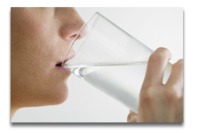This is a commonly asked question, as is “when do I need to recalibrate my analyzer?”
The FX-CL series amperometric chlorine residual analyzer is designed to operate continuously, 24 hours a day, 365 days a year. The system requires little routine maintenance other than changing the vinegar buffering agent bottle as it becomes depleted and occasional calibration checks.
 As part of a standard quality control procedure, we recommend the analyzer readings be verified using an accurate chlorine residual test instrument once every 7 days. In many applications, using a portable DPD colorimetric residual analyzer for routine calibration checks is sufficient to meet reporting requirements. For the utmost precision or in critical applications we recommend comparison with an amperometric titrator.
As part of a standard quality control procedure, we recommend the analyzer readings be verified using an accurate chlorine residual test instrument once every 7 days. In many applications, using a portable DPD colorimetric residual analyzer for routine calibration checks is sufficient to meet reporting requirements. For the utmost precision or in critical applications we recommend comparison with an amperometric titrator.
Calibration is typically done on an as needed basis, or at the minimum frequency specified by regulatory requirements. Barring any changes to the process or analyzer, the analyzer should be calibrated at least once per year.
You Need to Calibrate When:
If any of the following situations occur you should first verify residual measurements, make any required corrective measures, and recalibrate the analyzer.
-
If readings are not within ± 0.1 mg/L or ± 15% of a routine grab sample measurement.
-
If there is a change in sample flow rate to the analyzer.
-
If readings gradually drift up or down and there have been no apparent changes to the process.
-
If readings suddenly or unexpectedly change by a large amount. (NOTE: if the residual drops dramatically or to zero, first make sure you have sample flowing into the measuring cell, as evidenced by a discharge from the left drain under the measuring cell).
-
If the analyzer has been off line long enough to discolor or oxidize the copper negative cell.
-
If there is a change in the sample or if the analyzer is sampling a different source.
-
If the measuring range is changed.
-
After performing maintenance.
Calibration Guidelines:
You cannot simply enter calibration values with the analyzer running dry, with values that you expect to see, or with values from previous calibrations.
Calibration is always performed using water from your process.
Always set the zero point first.
When calibrating the zero point you must use dechlorinated process water, not distilled or deionized water.
Allow the measuring cell time to stabilize after switching water sources during calibration.
The standard, or span calibration value should be determined at about half of the analyzer's operating range.
Allow the measuring cell to stabilize to the process for 2-24 hours upon initial startup, after returning an offline analyzer to service, or after replacing the negative cell.




